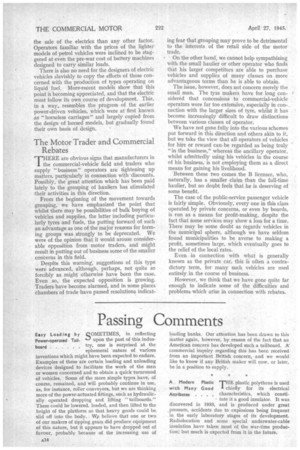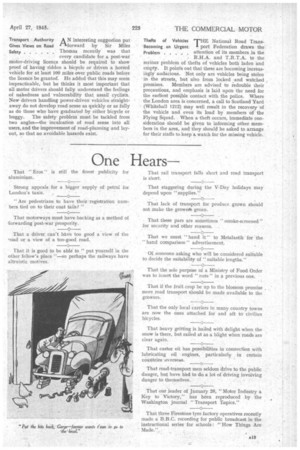Passing Comments
Page 16

Page 17

If you've noticed an error in this article please click here to report it so we can fix it.
SOMETIMES, in reflecting upon the past of this industry, one is surprised at the ephemeral nature of various inventions which might have been expected to endure.
• ExarapIes of these are certain loading and unloading devices designed to facilitate the work of the men or women concerned and to obtain a quick-tun:1round of vehicles. Some of the more simple types have, of course, remained, and will probably continue in use, as, for instance, roller conveyors, but we are thinking more of the power-actuated fittings, such as hydraulically operated dropping and lifting "tailboards." These could be lowered, loaded, and then lifted to the height of the platform so that heavy goods could be slid off into the body. W.,e believe that one or two of our makers of tipping gears did produce equipment of this nature, but it appears to have dropped out of favour, probably because of the increasing use of Easy Loading by Power-operated Tail
board
loading banks. Our attention haS been. drawn to this matter again. however, by reason of the fact that an • American concern has developed such a tailboard. A' commercial inquiry regarding this has been received from an important British concern, and we would like to know if any British maker will now, or later, . be in a position to supply.
A Modern Plastic THE plastic polythene is used with Many Good I chiefly for its electrical
Attributes . . . characteristics, which coristi tute it a good insulator. It was discovered in 1933, and is produced under great _pressure, accidents due to explosions being frequent in the early laboratory stages of its development. Racliolocation and some special underwater-cable insulation have taken most of the War-time production; but much is expected from it in the future.
Transport Authority A N interesting suggestion put Gives Views on Road i—iforward by Sir Miles
Safety Thomas recently was that every candidate for a post-war motor-driving licence should be required to show proof of having ridden a bicycle or driven a horsed vehicle for at least 100 miles over public roads before the licence be granted'. He added that this may seem impracticable, but he thinks it most important that all motor drivers should fully understand the feelings of nakedness and vulnerability that assail cyclists. New drivers handling power-driven vehicles straightaway do not develop road sense as quickly or as fully as do those who have graduated by either bicycle or buggy. The safety problem must be tackled from two angles—the inculcation of road sense into all users, and the improvement of road-planning and layout, so that no avoidable hazards exist.
Thefts of Vehicles THE National Road Trans Becoming an Urgent port Federation draws the
Problem attention of its members in the R.H.A. and T.R.T.A. to the serious problem of thefts of vehicles both laden and empty. It points out that these are becoming increasingly audacious. Not only are vehicles being stolen in the streets, but also from locked and watched premises. Members are advised to redouble their precautions, and emphasis is laid upon the need for the earliest possible contact with the police. Where the London area is concerned, a call to Scotland Yard (Whitehall 1212) may well result in the recovery of the vehicle •and even its load by members of the Flying Squad. When a theft occurs, immediate consideration should be given to informing other members in the area, and they should be asked to arrange for their staffs to keep a watch for the missing vehicle.




















































